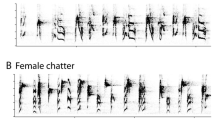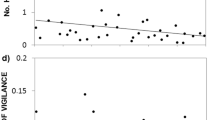Summary
Badge size, which functions as a signal of dominance status in male house sparrows Passer domesticus, was significantly related to their sexual behavior. Males with large badges participated in communal displays (multi-male chases directed towards single females) more often than males with small badges, irrespective of whether the female involved was the male's mate or not. Experimentally released females were more often chased if they were fertile than if they were nonfertile. Estradiol-implanted females were chased more often than control females without a hormone implant, and males with large badges chased estradiol-implanted females more often than did males with small badges. Both forced extra-pair copulations during communal displays and unforced extra-pair copulations were more often achieved by males with large than small badges. Male house sparrows with large badges also copulated with their mates at a higher rate than did males with small badges. A higher certainty of paternity therefore is hypothetized to accrue to male house sparrows with large badges.
Similar content being viewed by others
References
Alatalo RV, Gustafsson L, Lundberg A (1990) Phenotypic selection on heritable size traits — environmental deviations distort the prediction of the genetic response. Am Nat (in press)
Altmann J (1974) Observational study of behaviour: sampling methods. Behaviour 49:227–265
Andersson M (1982) Female choice selects for extreme tail length in a widowbird. Nature 299:818–820
Baker MC, Spitler-Nabors KJ, Bradley DC (1981) Early experience determines song dialect responsiveness of female sparrows. Science 214:819–821
Birkhead TR (1988) Behavioural aspects of sperm competition in birds. Adv Study Behav 18:35–72
Boag DA (1982) How dominance status of adult Japanese quail influences the viability and dominance status of their offspring. Can J Zool 60:1885–1891
Boag DA, Alway JH (1981) Heritability of dominance status among Japanese quail: a preliminary experiment. Can J Zool 59:441–444
Burke T, Davies NB, Bruford MW, Hatchwell BJ (1989) Parental care and mating behaviour of polyandrous dunnocks Prunella modularis related to paternity by DNA fingerprinting. Nature 338:249–251
Burrows WH, Titus HW (1939) Some observations in the semen production of the male fowl. Poult Sci 18:8–10
Charlesworth B (1987) The heritability of fitness. In: Andersson MB, Bradbury JW (eds) Sexual selection: testing the alternatives. Wiley, Chichester, pp 21–40
Clutton-Brock TH (ed) (1988) Reproductive success: studies of individual variation in contrasting breeding systems. University of Chicago Press, Chicago
Craig JV, Ortman LL, Guhl AM (1965) Genetic selection for social dominance ability in chickens. Anim Behav 13:114–131
Darwin C (1871) Sexual selection and the descent of man. Murray, London
Falconer DS (1983) Introduction to quantitative genetics, 2nd edn. Longman, London New York
Fisher RA (1958) The genetical theory of natural selection, 2nd edn. Dover, New York
Fugle GN, Rothstein SI, Osenberg CW, McGinley MA (1984) Signals of status in wintering white-crowned sparrows (Zonotrichia leucophrys gambelii). Anim Behav 32:86–93
Gustafsson L (1986) Lifetime reproductive success and heritability: empirical support for Fisher's fundamental theorem. Am Nat 128:761–764
Hansen P (1974) A comparative study of vocal behaviour of house sparrow Passer domesticus and tree sparrow Passer montanus. MSc thesis, University of Aarhus, Aarhus, Denmark (in Danish; English summary)
Hegner, RE, Wingfield JC (1986) Behavioral and endocrine correlates of multiple brooding in the semicolonial house sparrow Passer domesticus. Horm Behav 20:294–326
Holberton RL, Able KP, Wingfield JC (1989) Status signalling in dark-eyed juncos, Junco hyemalis: plumage manipulations and hormonal correlates of dominance. Anim Behav 37:681–689
Järvi T, Bakken M (1984) The function of the variation in the breast stripe of the great tit (Parus major). Anim Behav 32: 590–596
Jones G (1986) Sexual chases in sand martins (Riparia riparia): cues for males to increase their reproductive success. Behav Ecol Sociobiol 19:179–185
Manwell C, Baker CMA (1975) Molecular genetics of avian proteins. XIII. Protein polymorphism in three species of Australian passerines. Aust J Biol Sci 28:545–557
Martin PA, Dziuk PJ (1977) Assessment of relative fertility of males (cockerels and boars) by competitive mating. J Reprod Fertil 49:323–329
Martin PA, Reimers TJ, Lodge JR, Dziuk PJ (1974) The effect of ratios and numbers of spermatozoa mixed from two males on the proportion of offspring. J Reprod Fertil 39:251–258
Møller AP (1987a) Variation in badge size in male house sparrows Passer domesticus: evidence for status signalling. Anim Behav 35:1637–1644
Møller AP (1987b) House sparrow, Passer domesticus, communal displays. Anim Behav 35:203–210
Møller AP (1987c) Social control of deception among status signalling house sparrows Passer domesticus. Behav Ecol Sociobiol 20:307–311
Møller AP (1988a) Badge size in the house sparrow Passer domesticus. Effects of intra- and intersexual selection. Behav Ecol Sociobiol 22:373–378
Møller AP (1988b) Female choice selects for male sexual ornaments in the monogamous swallow. Nature 332:640–642
Møller AP (1989) Natural and sexual selection on a plumage signal of status and on morphology in house sparrows, Passer domesticus. J Evol Biol 2:125–140
Møller AP, Erritzøe J (1988) Badge, body and testes size in house sparrows Passer domesticus. Ornis Scand 19:72–73
Moss R, Watson A, Rothery P, Glennie W (1982) Inheritance of dominance and aggressiveness in captive red grouse Lagopus lagopus scoticus. Aggress Behav 1:1–18
Mousseau TA, Roff DA (1987) Natural selection and the heritability of fitness components. Heredity 59:181–197
Parker JE, McKenzie FF, Kempster HL (1940) Observations on the sexual behavior of New Hampshire males. Poult Sci 19:191–197
Perry EJ (ed) (1968) The artificial insemination of farm animals, 4th edn. Rutgers University Press, New Brunswick
Price DK, Collier GE, Thompson CF (1989) Multiple parentage in broods of house wrens: genetic evidence. J Hered 80:1–5
Price T, Kirkpatrick M, Arnold SJ (1988) Directional selection and the evolution of breeding date in birds. Science 240:798–799
Quinn TW, Quinn JS, Cooke F, White BN (1987) DNA marker analysis detects multiple maternity and paternity in single broods of the lesser snow goose. Nature 326:392–394
Rohwer S (1975) The social significance of avian winter plumage variability. Evolution 29:593–610
Searcy WA, Marler P (1981) A test for responsiveness to song structure and programming in female sparrows. Science 213:926–928
Siegel S (1956) Nonparametric statistics for the behavioral sciences. McGraw-Hill Kogakusha, Tokyo
Smith SM (1988) Extra-pair copulations in black-capped chicadees: the role of the female. Behaviour 107:15–23
Sokal RR, Rohlf FJ (1981) Biometry, 2nd edn. Freeman, San Francisco
Svensson L (1984) Identification guide to European passerines, 3rd edn. Svensson, Stockholm
Westman B (1990) Environmental effect on dominance in young great tits Parus major: a cross-fostering experiment. Ornis Scand 21 (in press)
Westneat DF (1987) Extra-pair copulations in a predominantly monogamous bird. Anim Behav 35:865–886
Wetton JH, Carter RE, Parkin DT, Walters D (1987) Demographic study of a wild house sparrow population by DNA fingerprinting. Nature 327:147–149
Author information
Authors and Affiliations
Rights and permissions
About this article
Cite this article
Møller, A.P. Sexual behavior is related to badge size in the house sparrow Passer domesticus . Behav Ecol Sociobiol 27, 23–29 (1990). https://doi.org/10.1007/BF00183309
Received:
Accepted:
Issue Date:
DOI: https://doi.org/10.1007/BF00183309




